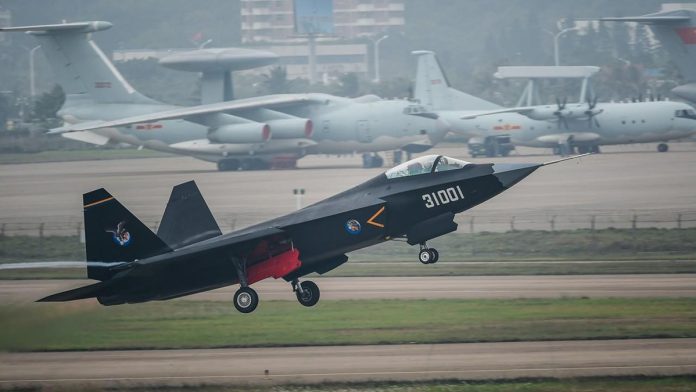A new horizon in Pakistan’s defense capabilities
Mirza Kashif Baig
The FC31, a cutting-edge stealth fighter jet, represents a significant leap in aerial combat technology. Developed with advanced capabilities, it promises to revolutionize modern warfare. This article delves into the intricacies of the FC31, contrasting it with its counterpart, the F36 Fighter Jet, and explores its strategic benefits to Pakistan. In juxtaposition, the F36 Fighter Jet, known for its technological prowess, serves as a benchmark to assess the advancements and capabilities of the FC31. For Pakistan, the acquisition of the FC31 is more than an upgrade in military hardware; it’s a strategic move with far-reaching implications for national defense and regional stability.
Early development and evolution
The journey of the FC31 began in the early 2000s, to create a stealth fighter jet that could match or surpass the capabilities of contemporary Western aircraft. Initially conceptualized as a response to U.S. and European fighter technology advancements, the FC31’s development focused on stealth, agility, and multi-role capabilities.
Breakthroughs and challenges
Throughout its development, the FC31 encountered numerous challenges, ranging from technological hurdles to budget constraints. Yet, each obstacle was met with innovative solutions, resulting in breakthroughs in stealth technology, avionics, and weapons systems. These advancements not only marked the FC31 as a formidable aircraft but also as a testament to the evolving aerospace industry. Today, the FC31 stands as a fully developed fifth-generation fighter jet, ready to be deployed. Its journey from conceptual drawings to a flying prototype is a story of resilience and technological ambition, reflecting the broader aspirations of modern aerial warfare.
Design and stealth features
The FC31’s design is a testament to modern stealth technology. Its sleek, aerodynamic structure is coated with advanced radar-absorbent materials, drastically reducing its visibility on enemy radars. The design intricacies extend to minimizing its infrared emissions, a critical aspect of stealth technology, allowing the jet to operate with a significantly lower chance of detection.
Engine and performance
At the heart of the FC31’s performance are its two state-of-the-art RD-93MA turbofan engines. Each engine delivers up to 9,000 kgf of thrust, propelling the jet to a top speed of approximately Mach 1.8. The high thrust-to-weight ratio ensures outstanding agility, crucial for evading enemy defenses and engaging in dogfights. Moreover, the engines are engineered to minimize heat emissions, aligning with the aircraft’s stealth profile, and reducing its vulnerability to infrared-guided systems.
Avionics and systems
The FC31’s advanced avionics system is centered around the KLJ-7A AESA radar. This radar system represents a significant leap in aerial combat technology, with the capability to track and engage multiple targets at long ranges, enhancing the jet’s situational awareness and offensive capabilities. The cockpit boasts a glass cockpit layout with multifunctional displays, providing pilots with real-time data and a comprehensive view of the battlefield.
Armament and payload
In terms of armament, the FC31 is equipped to handle a range of modern warfare demands. Its internal weapons bay is designed to carry air-to-air missiles like the PL-12 and PL-21, as well as precision-guided bombs, maintaining a low radar signature. The aircraft also features external hardpoints, enabling it to carry additional payloads and adapt to diverse combat scenarios. This flexibility in armament allows the FC31 to perform various roles, from air superiority missions to ground attacks.
Electronic warfare and defense systems
The FC31’s electronic warfare suite is a key component of its defensive capabilities. This integrated system provides comprehensive electronic countermeasures, enabling the jet to disrupt enemy radar and communications effectively, thereby enhancing its survivability in hostile environments. The suite includes systems for electronic attack, protection, and support, offering a robust defense against electronic threats. Additionally, the defense systems of the FC31 are bolstered by advanced countermeasures like chaff and flare dispensers. These systems are critical for misleading incoming missiles and protecting the aircraft from enemy fire. The jet is also equipped with an infrared search and track system (IRST) and a missile approach warning system, providing a multi-faceted defense strategy that can counter a variety of aerial threats.
Comparative analysis with f36 fighter jet design philosophy and stealth capabilities
The FC31 and F36 both exemplify cutting-edge stealth technology, yet the FC31 stands out with its balanced approach to stealth and cost. While the F36 prioritizes all-aspect stealth, potentially increasing its production and maintenance costs, the FC31’s design achieves an effective blend of stealth, agility, and affordability. Its use of radar-absorbent materials and aerodynamic shape significantly reduces radar detection, offering substantial stealth capabilities that are more accessible and maintainable for many nations.
Engine power and performance
The FC31’s RD-93MA engines, though not as advanced as the F36’s propulsion system, offer remarkable power and efficiency. The FC31 achieves a top speed of around Mach 1.8, demonstrating notable agility and speed, essential for modern aerial combat. This makes the FC31 an excellent choice for countries seeking high performance without the extensive cost associated with more sophisticated engines.
Avionics and radar systems
In avionics, the FC31’s KLJ-7A AESA radar system offers a commendable balance between capability and cost. While the F36’s radar systems provide longer detection ranges and precision targeting, the FC31’s avionics are highly effective in their own right, offering excellent situational awareness and the ability to engage multiple targets, a significant advantage in complex aerial battles.
Armament and versatility
The FC31 matches the F36 in terms of armament versatility, capable of carrying a wide array of modern weapons in its internal bay and on external hardpoints. This adaptability is crucial for fulfilling various combat roles, from air superiority to ground attacks. The FC31’s weapon system integration, while slightly less advanced than the F36’s, still delivers formidable firepower, making it a powerful asset in any air force.
Electronic warfare and defensive systems
The FC31’s electronic warfare systems are particularly noteworthy. Though the F36 boasts advanced electronic countermeasures, the FC31’s systems are impressively effective, capable of jamming enemy radars and communications, which are essential for modern electronic warfare. Its defense systems, including chaff, flares, and missile approach warning systems, ensure the jet’s survivability, rivaling the defensive capabilities of more expensive jets like the F36.
Cost and accessibility
A key advantage of the FC31 is its accessibility and cost-effectiveness compared to the F36. The FC31 offers a high-tech solution for nations looking to modernize their air forces without the prohibitive costs associated with top-tier stealth fighters. This affordability does not come at the expense of capability; the FC31 still provides a potent combination of stealth, firepower, and versatility, making it an attractive, strategic choice for countries seeking to enhance their aerial combat capabilities.
Strategic advantage for users
For countries like Pakistan, the FC31 presents a strategic advantage. It offers a sophisticated platform capable of leveling the playing field against more advanced adversaries. The balance of cost, performance, and advanced features makes the FC31 not just a fighter jet, but a symbol of accessible, high-end military technology.
Implications for Pakistan enhancing air force capabilities
The induction of the FC31 into Pakistan’s air force is poised to revolutionize its aerial combat capabilities. This state-of-the-art stealth fighter jet, with its blend of advanced stealth features, potent engine performance, and cutting-edge avionics, elevates Pakistan’s aerial warfare capabilities to new heights. The FC31’s agility and high-speed capabilities, combined with its stealth attributes, render it an ideal asset for securing air superiority in diverse combat scenarios.
Strengthening national defense
The addition of the FC31 significantly bolsters Pakistan’s national defense. Its advanced electronic warfare systems and comprehensive defense mechanisms position it as a formidable opponent against potential adversaries. The jet’s multi-role capabilities, capable of executing a variety of missions ranging from air-to-air combat to precision ground strikes, provide Pakistan with a dynamic and flexible defense tool.
Balancing regional power dynamics
Acquiring the FC31 is a strategic move by Pakistan to maintain equilibrium in regional power dynamics. Its deployment serves as a deterrent against adversaries, leveling the playing field against nations with more advanced military technologies. The FC31’s introduction into Pakistan’s arsenal ensures the nation can defend its airspace effectively and assert its strategic position in the region.
Cost-effectiveness and operational efficiency
The FC31’s cost-effectiveness is a crucial factor for Pakistan. Its acquisition and operational costs are considerably lower than other fifth-generation fighters, offering advanced capabilities without overburdening the national defense budget. This efficiency extends to maintenance and operational expenses, with the FC31 requiring less upkeep than more complex aircraft, making it a practical choice for a country looking to modernize its air force efficiently.
Potential for indigenous development and upgrades
The FC31 opens doors for indigenous aerospace development and technological advancements in Pakistan. Collaboration in the development and manufacturing of the FC31 can bolster Pakistan’s technical expertise in defense technology, leading to potential upgrades and customizations specific to its defense requirements. This partnership is a step towards self-reliance in defense capabilities and technological sovereignty.
Enhancing international defense collaboration
Integrating the FC31 into Pakistan’s defense forces signifies strengthened international defense collaborations. This cooperation, especially with countries involved in the FC31’s development and production, enhances diplomatic and defense relations, bolstering Pakistan’s standing in global defense and security arenas.
Training and skill development
Operating the FC31 offers a unique opportunity for the Pakistan Air Force to advance its training programs and develop new competencies among its personnel. The exposure to advanced fighter jet technologies will enhance the skills and readiness of both pilots and ground technicians, preparing them for the demands of modern aerial warfare.
Long-term strategic implications
The long-term strategic implications of incorporating the FC31 into Pakistan’s defense strategy are profound. This move signifies Pakistan’s commitment to sustaining a formidable and technologically advanced military presence, crucial for national security in a rapidly evolving global context.
Regional security and stability
The FC31’s presence in Pakistan’s arsenal contributes to regional security and stability. By possessing a credible aerial defense capability, Pakistan can better manage regional tensions and conflicts, ensuring a more balanced security environment. The FC31’s capabilities enable Pakistan to engage in effective deterrence, reducing the likelihood of escalation and fostering a more stable regional security landscape.
Economic benefits
The FC31 program also presents significant economic benefits. The technology transfer and collaboration involved in the FC31’s development and production can spur growth in Pakistan’s aerospace industry, creating jobs and fostering technological innovation. This economic boost can have ripple effects across various sectors, contributing to overall national development.
Enhancing air-to-air and air-to-ground capabilities
The FC31’s advanced weaponry and versatile loadout options enhance Pakistan’s air-to-air and air-to-ground capabilities. Its ability to carry a range of sophisticated weapons systems enables the Pakistan Air Force to effectively engage in diverse combat operations, from intercepting enemy aircraft to striking strategic ground targets with precision.
Intelligence, surveillance, and reconnaissance (ISR) enhancements
The FC31’s advanced sensor and radar systems significantly improve Pakistan’s intelligence, surveillance, and reconnaissance capabilities. The ability to gather and process critical information in real-time enhances situational awareness, providing Pakistan with an edge in strategic planning and decision-making.
Building a future-ready air force
Integrating the FC31 into Pakistan’s military aligns with the broader goal of building a future-ready air force. The FC31’s advanced features and capabilities position Pakistan’s air force as a technologically advanced and strategically capable force, ready to face the challenges of future warfare scenarios. In conclusion, the FC31 fighter jet emerges not just as an advanced piece of military hardware, but as a pivotal element in reshaping Pakistan’s defense capabilities. With its sophisticated stealth features, powerful engines, and state-of-the-art avionics, the FC31 stands as a testament to modern aerial combat technology.
Its introduction into Pakistan’s air force significantly enhances the country’s air superiority, strengthens national defense, and balances regional power dynamics. The FC31’s cost-effectiveness, combined with its operational efficiency and potential for indigenous development, makes it a strategic choice for Pakistan. It represents not only a leap in military prowess but also a step towards technological self-reliance and enhanced international defense collaboration. As Pakistan integrates this advanced fighter jet into its arsenal, it solidifies its position as a formidable player in regional and global defense, ready to face the challenges of modern warfare with confidence and capability.
The author is the Editor of Monthly Interaction.







